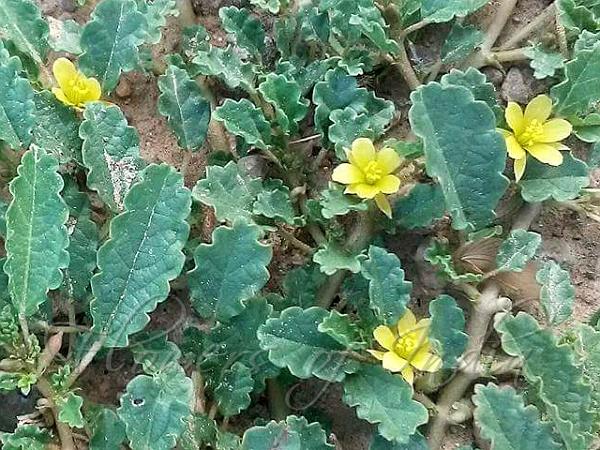|
| Bahuphali |
|

|

|
|
|
|
Photo: |
Botanical name: Corchorus depressus Family: Tiliaceae (Falsa family)
Synonyms: Corchorus antichorus, Corchorus humilis, Corchorus microphyllus
Synonyms: Corchorus antichorus, Corchorus humilis, Corchorus microphyllus
Bahuphali is a mat forming, prostrate, much branched
woody perennial. Flowers are borne in mostly 2-flowered cymes,
flower-cluster-stalk minute. Flowers are yellow, 6-8 mm across,
flower-stalk about 1 mm long. Sepals are yellowish-green,
linear-oblong, 3-4 mm long, spreading, pointed. Petals are
obovate-spoon-shaped, as long as sepals, blunt. Stamens are 8-10,
filaments about 4 mm long, erect. Stems are diffusely branched from
woody rootstock, young branches sparsely hairy, older ones hairless.
Leaves are 3-ribbed, elliptic to broadly elliptic, 4-18 mm long, 2-9 mm
broad, hairless except the scattered hairy costae, plicate in bud,
rounded toothed-sawtoothed, without basal bristly appendages, blunt.
Leaf-stalks are 1.5-2.5 cm long, thread-like, stipules linear-curved,
about 2 mm long. Capsules are oblong-cylindric, straight or curved,
becoming hairless, 7-22 mm long, with about 1.5-2 mm long beak,
4-loculed, locules transversely septate. Bahuphali is found in Central
and North West India and Pakistan to north and tropical Africa and Cape
Verde Islands.
Flowering: February-November.
| Identification credit: Ankush Dave | Photographed in Dholpur, Rajasthan. |
• Is this flower misidentified? If yes,